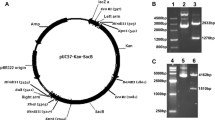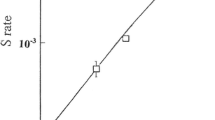Summary
Casadaban (1976) developed a technique for isolating E. coli clones containing fusions of the amino terminal-encoding portion of any cistron with the carboxy terminal-encoding portion of lacZ. The technique utilizes prophage Mu homology to bring the two cistrons into proximity. I have followed the appearance over time of colonies containing araB-lacZ fusions from a strain where the begining of the araB cistron is connected to lacZ by an intact Mucts62 prophage. Cultures of the starting strain grown on a variety of media have fewer than 2 in 1010 cells capable of forming colonies within three days after plating on selective arabinose-lactose medium. At 32°C, there is a delay of between 4 and 19 days before the first colony appears. The kinetics of colony appearance over the next two to four weeks then shows a rapid increase in the number of new colonies emerging per day followed by a decline. The pattern of colonial emergence and the final numbers of fusion colonies obtained are not grossly affected by reducing the number of cells plated over five orders of magnitude. Fusion colonies sometimes show a clustered pattern when they first emerge. Innoculation of pre-existing fusion clones at specific locations on the arabinose-lacteredselection plates seeded with the starting strain leads to the formation of inhibitory zones where no fusion colonies appear. Selection plates contain many microcolonies and papillae which do not proliferate into scoreable colonies but nonetheless contain cells capable of growth when replated on the same selective medium. Up to 39% of all plated cells are capable of producing fusion clones. The kinetics of fusion colony appearance can be altered by environmental and genetic manipulations. Partial derepression of the Mucts prophage at 37° accelerates the appearance of colonies but also reduces the final yield. Addition of limiting concentrations of glucose to the selective medium also accelerates the appearance of colonies in a specific fashion: enrichments below the level required for maximum acceleration produce a biphasic kinetics with two waves of fusion clone emergence separated by an eight-day interval. Infection with Muc + pAp phage produces dilysogens that have almost completely lost the ability to produce fusions. Infection with MuctsAampAP phage produces strains that are reduced in phage production and have delayed kinetics of fusion clone emergence. The implications of these observations for theories of hereditary change in bacteria are discussed.
Similar content being viewed by others
References
Bassford P, Beckwith J, Berman M, Brickman E, Casadaban M, Guarente L, Saint-Girons I, Sarthy A, Schwartz M, Silhavy T (1978) Genetic fusion of the lac operon: A new approach to the study of biological processes. In: Miller J, Reznikoff W (eds) The Operon. Cold Spring Harbor Laboratory, Cold Spring Harbor, NY, pp 245–261
Casadaban M (1976) Transposition and fusion of the lac genes to selected promoters in Escherichia coli using bacteriophage lambda and Mu. J Mol Biol 104:541–555
casadaban M, Chou J (1984) In vivo formation of hybrid protein β-galactosidas gene fusions in one step with a new transposable Mu-lac transducing phage. Proc Natl Acad Sci USA, in press
Hall M, Silhavy T (1981) The ompB locus and the regulation of the major outer membrane porin proteins of Escherichia coli K12. J Mol Biol 146:23–43
Leach D, Symonds N (1979) The isolation and characterisation of a plaque-forming derivative of bacteriophage Mu carrying a fragment of Tn3 conferring ampicillin resistance. Mol Gen Genet 172:179–184
Lederberg J, Lederberg E (1952) Replica plating and indirect selection of bacterial mutants. J Bacteriol 63:399–408
Lee N, Bendet I (1967) Crystalline L-ribulokinase from Escherichia coli. J Biol Chem 242:2043–2046
Luria S, Delbrück M (1943) Mutations of bacteria from virus sensitivity to virus resistance. Genetics 28:491–504
Mitchell D, Reznikoff W, Beckwith J (1974) Genetic fusions defining trp and lac regulatory elements. J Mol Biol 93:331–350
Moreno F, Fowler A, Hall M, Silhavy T, Zabin I, Schwartz M (1980) A signal sequence is not sufficient to lead β-galactosidase out of the cytoplasm. Nature 286:356–359
Muster CJ, MacHattie LA, Shapiro JA (1983) The pλCM system: Observations on the roles of transposable elements in the formation and breakdown of plasmids derived from bacteriophage λ replicons. J Bacteriol 153:976–990
Newcombe HB (1949) Origin of bacterial variants. Nature (London) 164:150
Shapiro JA (1984a) Transposable elements, genome reorganization and cellular differentiation in gram-negative bacteria. In: The Microbe 1984. Symp Soc Gen Microbiol 36: Part 2, 169–193
Shapiro JA (1984b) The use of Mudlac transposons as tools for vital staining to visualize clonal and non-clonal patterns of organization in bacterial growth on agar surfaces. J Gen Microbiol in press
Shapiro J, MacHattie L, Eron L, Ihler G, Ipper K, Beckwith J, Arditti R, Reznikoff W, MacGillivray R (1969) The isolation of pure lac operon DNA. Nature (London) 224:768
Shuman H, Silhavy T, Beckwith J (1980) Labeling of proteins with β-galactosidase by gene fusion. J Biol Chem 255:168–174
Silhavy T, Casadaban M, Shuman H, Beckwith J (1976) Conversion of β-galactosidase to a membrane-bound state by gene fusion. Proc Natl Acad Sci USA 73:3423–3427
Tonegawa S, Sakano H, Maki R, Traunecker A, Heinrich G, Roeder W, Kurosawa Y (1981) Somatic reorganization of immunoglobulin genes during lymphocyte differentiation. Cold Spring Harbor Symp Quant Biol 45:839–858
Toussaint A, Resibois A (1983) Phage Mu: Transposition as a lifestyle. In: Shapiro J (ed) Mobile Genetic Elements. Academic Press, New York, pp 105–158
Zabin I, Fowler A, Beckwith J (1978) Position of the mutation in beta-galactosidase ochre mutant U118. J Bacteriol 142:732–734
Author information
Authors and Affiliations
Additional information
Communicated by W. Arber
Rights and permissions
About this article
Cite this article
Shapiro, J.A. Observations on the formation of clones containing araB-lacZ cistron fusions. Molec. Gen. Genet. 194, 79–90 (1984). https://doi.org/10.1007/BF00383501
Received:
Issue Date:
DOI: https://doi.org/10.1007/BF00383501




